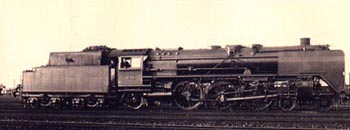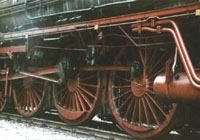| |
BR 01
BR 01 locomotive
Construction
Delivery
BR 01 locomotive
After the founding of the DRG, the DRG made an inventory of the old Länderbahn locomotives. It appeared that there was a big need for new and standardized locomotives. Standardized locomotives had many similar parts in common, and consisted of large series. At this way the maintenance costs were very low. In May 1921, the commission for standardized locomotives had decided that they must built a new steam engine for express trains.
 | | BR 01.0-2 steam locomotive of the DRG |
As a result they set up a program with 12 standardized steam engines who were strong influenced by the Prussian steam engines. The first locomotive had to be a locomotive with an axle layout of 2'C1' and must had an axle load of 20 t. They demanded of this locomotive that it could ride a train with a weight of 800 t with 100 km/h, and that it could ride a train with a weight of 500 t with 50 km/h on a climbing track of 10 ‰. The top speed for this locomotive had to be 120 km/h. To build locomotives for this locomotive program, manufacturers like Borsig and AEG were brought in.
The proposals for Borsig, Henschel and Maffei were mainly four cylinder steam engines with one and two axles powered. They considered to build another 2'C1' locomotive with a two cylinder power. In 1925 the DRG took the decision to order ten steam engines of both sorts. The DRG wanted to try them in a testprogram and in that testprogram the DRG wanted to discover which locomotive was the best. The two cylinder locomotives were built by Borsig and got the numbers: 01 001 up to 008 and the numbers 01 009 and 010 were built by AEG. Henschel built the four cylinder locomotives 02 001 up to 008 and Maffei built the locomotives 02 009 and 010. After the locomotives were build and the testprogram was completed the DRG decided to choose for the 01 series.
Construction
 | | Driving shafts of the BR 01 |
The steam engines of type BR 01 were the first built steam engines in the standardized program. The steam engines were built to ride express trains. The essence of type BR 01 was a simple steam engine. But the BR 01 was equiped with many devices and instruments. The appearance of the BR 01 was like many standardized steam engines, influenced by Prussian steam engines. The steam engines from number 01 102 had wheels with a diameter of 1000 mm. The top speed was 120-130 km/h. The airpump, originally placed behind the big spoilers, was moved to the middle of the steam engine.
Delivery
In 1927 the mass-production of the BR 01 started. This second series, delivered the steam engines 01 102 up to 01 076 (locomotives 01 001 up to 01 010 were the prototype steam engines and the first series). This second series was delivered until 1928. The steam engines from this series had the little spoilers and had a boiler with a length of 5,8 meter.
The third series delivered the steam engines with numbers 01 077 up to 01 101. The boiler of these steam engines was lengthen to 6,80 meter and had a closed frontskirt under the door of the smoke box. The diameter of the cylinder was reduced from 65 centimeter to 60 centimeter.
From 1934 until 1936 the fourth series was delivered with the steam engines 01 102 up to 01 190. The locomotives were built by the Berliner Maschinenbau AG, Henschel and Krupp. The diameter of the wheels was extended from 85 centimeter to 1 meter and they had improved brakes. The top speed of these steam engines of the fourth series was 130 km/h. The fifth and last series was delivered in 1937/38 with the steam engines 01 191 up to 01 232. These steam engines had a few modifications. Altogether there are built and delivered 231 steam engines of type BR 01 between 1925 and 1938.
| Axle layout: |
2'C1'h2 |
| In service: |
1925-1938 |
| Diameter driving wheels: |
85 cm, from the fourth series 100 cm |
Lengte over de buffers
(met tender 2'2'T32): |
23,94 meter (001-012: 23,75 meter) |
| Top speed: |
120 km/h, from the fourth series 130 km/h |
| Power: |
1647 kW/2240 pk |
| Boiler pressure: |
16 bar |
| Vaporize surface: |
247,15 m2 |
| Cylinder diameter: |
65 cm, from the third series 60 cm: |
| Maximum axle load: |
19,90 t |
| Weight (without tender): |
108,9 t (001-101),
111,3 t (102-232) |
| Eisenbahn Fahrzeug Katalog, Band 5 Einheits-Dampflokomotiven. |
| |
| GeraNova, München, |
| |
|
